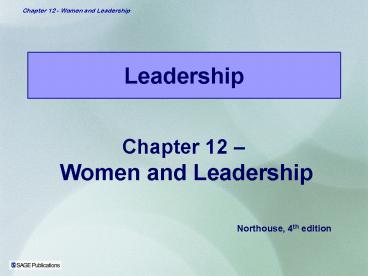Leadership - PowerPoint PPT Presentation
1 / 39
Title:
Leadership
Description:
Chapter 12 - Women and Leadership. Women and Leadership Perspective. Gender ... leadership positions (Belkin, 2003; Ehrlich, 1989; Wadman, 1992); research does ... – PowerPoint PPT presentation
Number of Views:143
Avg rating:3.0/5.0
Title: Leadership
1
Leadership
Chapter 12 Women and Leadership
Northouse, 4th edition
2
Overview
- Women and Leadership Perspective
- Gender and Leadership Styles
- Gender and Leadership Effectiveness
- The Glass Ceiling
- Breaking the Glass Ceiling
- Women and Leadership Approach
3
Women and Leadership Approach Description
Historical View
- Gender and Leadership
- Popular press reported differences between women
and men - - Women inferior to men (1977)
- Women lacked skills traits necessary for
managerial success - Superiority of women in leadership positions
(1990) - Researchers ignored issues related to gender
leadership until the 1970s
4
Women and Leadership Approach Description
Historical View
- Gender and Leadership
- Scholars started asking Can women lead?
- Changed by women in leadership
- Presence of women in corporate political
leadership - Highly effective female leaders eBays CEO,
Avons CEO, N.Y. Senator, Secretary of State, etc.
5
Women and Leadership Approach Description
Historical View
- Gender and Leadership
- Current research primary questions
- What are the leadership style and effectiveness
differences between women and men? - Why are women starkly underrepresented in elite
leadership roles?
6
Gender and Leadership Styles
- Leadership Styles
- Mainstream press reported (1990-2000)
- There are gender differences
- Contemporary society womens leadership is more
effective - Researchers argue (1986-2001)
- gender has little or no relationship to
leadership style and effectiveness
7
Gender and Leadership Styles
- Meta-analysis (Eagly Johnson, 1990)
- Women were not found to lead in a more
interpersonally oriented less task-oriented
manner than men in organizations - Only gender difference - women use a more
participative or democratic style than men - Additional meta-analysis (van Egen, 2001)
examining research between 1987-2000 found
similar results
8
Gender and Leadership Styles
- Meta-analysis of male female leaders on all
characteristics and behaviors (Eagly, Makhijani,
Klonsky, 1992) - Women were devalued when they worked in
male-dominated environments and when the
evaluators were men - Females evaluated unfavorably when they used a
directive or autocratic style (stereotypically
male) - Female and male leaders evaluated favorably when
they used a democratic leadership style
(stereotypically feminine)
9
Gender and Leadership Styles
- Transformational Leadership (TL) Research (Lowe
et al, 1996) elements positively related to
leadership effectiveness - All 4 components of TL
- idealized influence, inspirational motivation,
intellectual stimulation, and individualized
consideration - The contingent reward component of transactional
leadership
10
Gender and Leadership Styles
- Transformational Leadership (TL) Meta-analysis
(Eagly et al, 2003) - Found differences between female male leaders
on these TL styles - womens styles tend to be more transformational
than mens - women tend to engage in more contingent reward
behaviors than men - all are aspects of leadership that predict
effectiveness
11
Gender and Leadership Effectiveness
- Meta-analysis comparing effectiveness of female
male leaders (Eagly et al, 1995) - Overall men and women were equally effective
leaders - Gender differences
- women and men were more effective in leadership
roles congruent with their gender - Women were less effective to the extent that
leader role was masculinized
12
Gender and Leadership Effectiveness
- Meta-analysis comparing effectiveness of female
male leaders (Eagly, et al, 1995), contd. - Women were
- less effective than men in military positions
- more effective than men in education, government,
and social service organizations
13
Gender and Leadership Effectiveness
- Meta-analysis comparing effectiveness of female
male leaders (Eagly, et al, 1995), contd. - Women were
- substantially more effective than men in middle
management positions interpersonal skills highly
valued - less effective than men when they
- supervised a higher proportion of male
subordinates - greater proportion of male raters assessed the
leaders performance
14
The Glass Ceiling
Evidence of the Glass Ceiling
- Women
- currently occupy more than half of all management
and professional positions - 50.3 (Catalyst,
2005) - make up nearly half of the U.S. labor force -
46.4 (U.S. Bureau of Labor Statistics, 2005) - Still underrepresented in upper echelons of
Americas corporations political system
15
The Glass Ceiling
Evidence of the Glass Ceiling
- Women
- represent only 5.2 of Fortune 500 top earners
- have 7.9 of highest titles in the Fortune 500
- represent less than 2 of Fortune 500 CEOs
(Catalyst, 2002) - hold only 14.7 of Fortune 500 board seats
- and, merely 3.4 of board seats are held by women
of color (Catalyst, 2006)
16
The Glass Ceiling
Evidence of the Glass Ceiling
- Women in Politics
- 81 of the 535 seats in the U.S. Congress - 15.1
- 14 in the Senate
- 15.4 in the House of Representatives
- women of color occupy just 20 seats - 3.7
(Center for the American Woman and
Politics, 2006) - World average of womens representation in
national legislatures or parliaments is 16.4
with the United States ranked 68th out of 188
countries
(Inter-Parliamentary Union, March 2006).
17
The Glass Ceiling
- Invisible barrier preventing women from ascending
into elite leadership - positions
- commonly called the glass ceiling
18
The Glass Ceiling
Motives for Removing the Barriers
- Glass Ceiling is a global phenomenon
- women are disproportionately concentrated in
lower-level lower-authority leadership
positions than men - encompasses ethnic and racial minorities as well
19
The Glass Ceiling
Motives for Removing the Barriers
- Important Motivations
- fulfill promise of equal opportunity
- find the most talented richly diverse group of
women - gender diversity associated with greater group
productivity, leads to increases in organizations
financial performance - as the number of women at the top increases, so
does financial success (Catalyst, 2004)
20
Explaining the Glass Ceiling
- Womens under representation in high-level
leadership positions revolve around three types
of explanations
21
The Glass Ceiling
Explaining the Glass Ceiling
- Human Capitol Differences
- Pipeline Theory - Women have not been in
managerial positions long enough for natural
career progression to occur (Heilman, 1997) not
supported by research - Division of labor leads women to self-select out
of leadership tracks by choosing mommy track
positions that do not funnel into leadership
positions (Belkin, 2003 Ehrlich, 1989 Wadman,
1992) research does not support this argument
(Eagly Carli, 2004)
22
The Glass Ceiling
Human Capitol Differences
- Women
- occupy more than half of all management
professional positions (Catalyst, 2005), but have
fewer developmental opportunities - fewer responsibilities in the same jobs as men
- are less likely to receive encouragement, be
included in key networks, and receive formal job
training than their male counterparts - confront greater barriers to establishing
informal mentor relationships
23
The Glass Ceiling
Gender Differences
- Women
- show the same level of identification with
commitment to paid employment roles as men - are less likely to promote themselves for
leadership positions than men - were less likely than men to emerge as group
leaders, more likely to serve as social
facilitators
24
The Glass Ceiling
Gender Differences
- Women
- face significant gender biases and social
disincentives when they self-promote - are less likely than men to ask for what they
want - are less likely to negotiate than men
- Psychological differences on traits often seen as
related to effective leadership - men showing slightly more assertiveness than
women - women showing somewhat higher levels of integrity
than men (Feingold, 1994 Franke, Crowne,
Spake, 1997)
25
The Glass Ceiling
Gender Differences
- Women and Effective Leadership
- Newer conceptualizations such as transformational
leadership - no longer highlight traditional masculine traits
- but rather highlight the importance of feminine
and androgynous traits
26
The Glass Ceiling
Prejudice
- Explanation for the glass ceiling
- gender bias stemming from stereotyped
expectations women take care and men take
charge - Survey of women executives from Fortune 1000
companies on reason for the glass ceiling - 33
of the respondents cited - stereotyping
- preconceptions of womens roles abilities as a
major contributor (Catalyst, 2003)
27
The Glass Ceiling
Prejudice
- Gender Stereotypes
- pervasive, well documented, and highly resistant
to change (Dodge, Gilroy Fenzel, 1995 Heilman,
2001) - men are stereotyped with agentic characteristics
- confidence, assertiveness, independence,
rationality, decisiveness - Stereotypical attributes of women include
communal characteristics - concern for others, sensitivity, warmth,
helpfulness, nurturance (Deaux Kite, 1993
Heilman, 2001)
28
The Glass Ceiling
Prejudice
- Prejudice helps explain numerous findings
- less favorable attitudes toward female than male
leaders - greater difficulty for women to attain top
leadership roles - greater difficulty for women to be viewed as
effective in top leadership roles (Eagly Karau,
2002)
29
Breaking the Glass Ceiling
- Research data suggests that the glass ceiling is
cracking - Convergence of factors contributes to leadership
effectiveness rise of female leaders
30
Breaking the Glass Ceiling
31
Breaking the Glass Ceiling
- Factors contributing to leadership effectiveness
rise of female leaders - Culture of many organizations is changing
- Gendered work assumptions are being challenged
- Organizations valuing flexible workers
diversity of top managers leaders
32
Breaking the Glass Ceiling
- Factors contributing to leadership effectiveness
rise of female leaders, contd. - Developing effective supportive mentoring
relationships - Greater negotiation power for women
- Effectiveness and predominance of women owned
businesses
33
Women and Leadership Approach
- Strengths
- Criticisms
- Application
34
Strengths
- Developing a more androgynous conception of
leadership will enhance leadership effectiveness
by giving people opportunity to engage in the
best leadership practices - Research on gender and leadership is productive
in both dispelling myths about the gender gap and
shining a light on aspects of the gender barrier
that are difficult to see and therefore are
overlooked
35
Strengths
- Understanding many components of the glass
ceiling will give us the tools necessary to
combat this inequality from many perspectives - Research addresses larger, more significant
considerations about gender and social systems
36
Criticisms
- Leadership researchers should put a greater
emphasis on understanding the role of race and
ethnicity (and other types of diversity) in
leadership processes - Researchers should examine the differences in the
impact of race or ethnicity and gender on
leadership
37
Criticisms
- Research into gender issues and leadership is
predominantly in Western contexts and should be
expanded into other global regions - Research on gender and leadership should be
expanded to include closing the gender gap at home
38
Application
- Make it easier for women to reach top positions
by - Understanding obstacles that make up the glass
ceiling - Initiating tactics to eradicate inequality
- Effective way to overcome biased expectations, is
continued use of - transformational behaviors
- contingent reward behaviors
39
Application
- Use of effective negotiation techniques aid in
procuring resources necessary at work/at home to
augment leadership advancement - Increase presence of women in prominent
leadership roles by - Changes in organizational culture
- womens career development
- mentoring opportunities for women
- increased numbers of women in strategic positions































